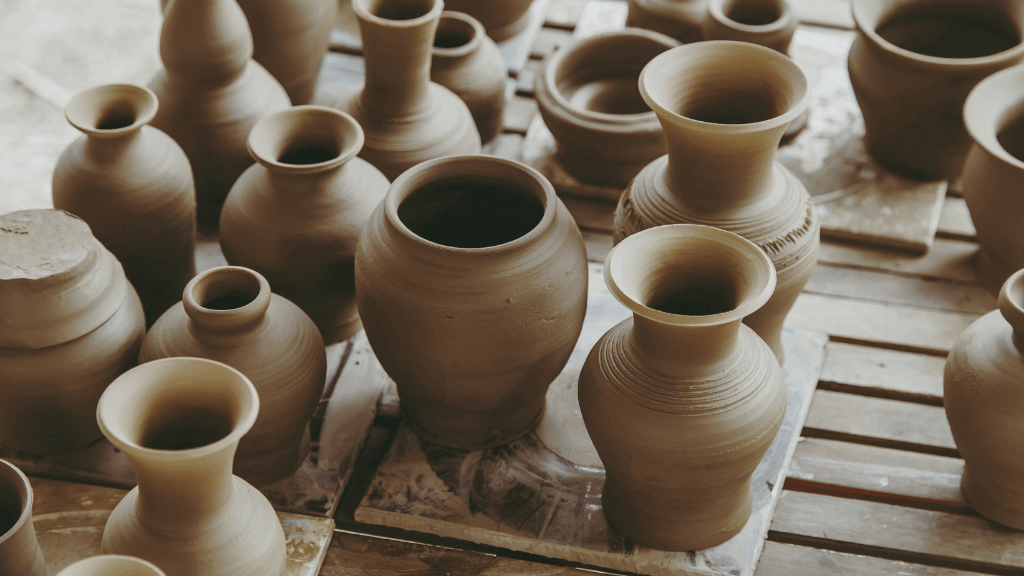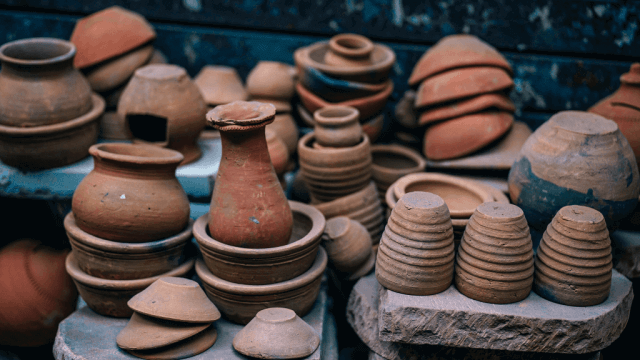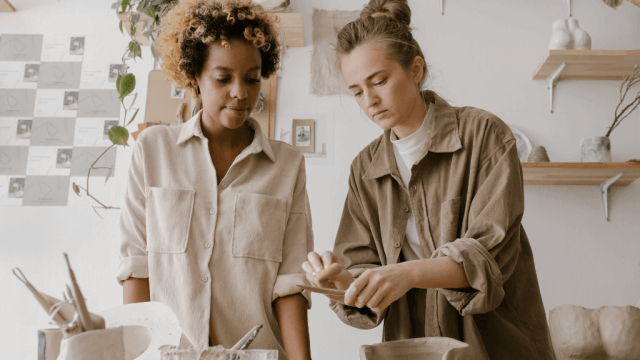Bisque pottery refers to unglazed ceramic ware that has undergone its first firing in a kiln.
The process transforms raw clay into a hard porous material that is less fragile and easier to handle.
Bisque-firing allows for more accurate glazing and helps avoid imperfections in the final glazed piece.
Understanding Bisque Pottery
Bisque pottery refers to unglazed ceramic ware that has undergone its first firing in a kiln.
The process transforms raw clay into a hard porous material that is less fragile and easier to handle.
Bisque-firing allows for more accurate glazing and helps avoid imperfections in the final glazed piece.
The Process of Creating Bisque Pottery
The process of creating bisque pottery involves a few essential steps.
Shaping the Clay
Artists start by choosing the appropriate type of clay for their project and using various techniques like slab building, wheel throwing, or hand-sculpting to shape the piece.
Drying the Clay
Once the desired shape and form are achieved, the clay is left to dry, typically around 1-2 weeks depending on its size and thickness.
The drying process is crucial to prevent cracking during the first firing.
Firing the Clay: The Bisque Firing
The bisque pottery is then fired in a kiln at a temperature between 1000°C (1832°F) and 1200°C (2192°F).
This process, called bisque firing, is crucial in creating a durable, porous base suitable for glazing and subsequent firings.
Cooling the Bisque Pottery
After the bisque firing, the piece is allowed to cool slowly to room temperature.
This cooling process must be done carefully to prevent cracks due to thermal shock.
Glazing and Final Firing
Applying Glaze
Once the bisque pottery has cooled, it is ready for glazing.
Artists can apply glazes using a variety of methods, such as pouring, brushing, or dipping.
The bisque’s porous texture allows it to absorb the glaze effectively, ensuring an even coat on the surface.
Gloss Firing
After the glaze has dried, the piece undergoes a final firing known as gloss firing.
This process fuses the glaze to the pottery surface, creating a smooth, glassy appearance.
Gloss firing occurs at a temperature between 940°C (1724°F) and 1300°C (2372°F) depending on the type of glaze and clay used.
The Final Product
Once the gloss firing process is complete, the bisque pottery emerges as a finished glazed ceramic piece.
The glaze offers protection and aesthetic appeal while simultaneously enhancing the durability and functionality of the pottery.
Types of Clays Used in Bisque Pottery
Different types of clay can be used for bisque pottery, each with its unique properties and suitability for various projects.
Some commonly used clays are:
- Earthenware: A low-firing clay that is porous and often orange or red in color.
Ideal for decorative pieces and hand building techniques.
- Stoneware: A high-firing clay that is dense and durable, making it suitable for functional pieces.
Generally found in gray, brown, or beige colors.
- Porcelain: A high-firing, white-colored translucent clay that has excellent strength and durability.
It is ideal for creating fine and delicate pottery items.
The Advantages of Bisque Pottery
Bisque pottery has several advantages that contribute to its popularity among artists and potters:
- Reduced Shrinkage: The bisque firing process reduces the clay’s moisture content, preventing further shrinkage during glazing and final firing.
This allows better control over the final size and shape of the piece.
- Increased Strength: The bisque firing transforms the raw clay into a hard, porous, and less fragile form, making it easier to handle and withstand the glazing process.
- Better Glaze Adherence: The porous nature of bisque-fired pottery allows glazes to adhere more effectively, ensuring a more even and consistent finish on the final piece.
- Reduced Glaze Defects: By using bisque pottery, artists can identify and fix any imperfections or cracks in the piece before applying the glaze, reducing the risk of glaze flaws and defects.
Tips for Successful Bisque Firing
To achieve the best results when creating bisque pottery, consider the following tips:
- Proper Drying: Ensure that your pottery is completely dry before bisque firing to prevent cracking from trapped moisture.
- Kiln Loading: Load the kiln carefully, leaving enough space between pieces for even heat distribution and avoiding stacking, as the pottery may become misshapen from the weight.
- Control Firing Temperature: Use a kiln controller or pyrometric cones to accurately monitor the temperature during the bisque firing to prevent over firing or under firing.
- Gradual Cooling: Allow the bisque pottery to cool slowly and evenly to avoid thermal shock, which can cause cracks and damage to the pieces.
FAQ: Frequently Asked Questions About Bisque Pottery
If you’re curious to learn more about bisque pottery, here are answers to some of the most commonly asked questions related to this topic:
Can I paint bisque-fired pottery without glazing it?
Yes, you can paint bisque-fired pottery without glazing it, but the paint may wear away over time or not provide a waterproof surface like glazing does.
Acrylic paint is commonly used for painting unglazed pottery, but it is mainly for decorative purposes and may not be suitable for functional or food-safe pieces.
How long does it take to bisque fire pottery pieces?
The exact duration of a bisque firing depends on the size and thickness of the pieces, the firing temperature, and the type of clay used.
Generally, bisque firing takes around 8 to 12 hours, followed by a cooling period of at least 12 to 24 hours to ensure the pottery has reached room temperature before handling.
What is the difference between bisque pottery and greenware?
Greenware refers to unfired clay items that have been shaped and dried but have not yet gone through the bisque firing process.
Bisque pottery, on the other hand, has undergone the first firing, which turns the greenware into a hard, porous ceramic material that is more durable and receptive to glazes.
Is bisque-fired pottery food safe?
Bisque-fired pottery is generally not food-safe until it has been glazed and undergone the final firing process (gloss firing).
The glaze layer provides a waterproof seal and prevents any contamination from the porous bisque material.
However, it is essential to use food-safe glazes that are lead-free and non-toxic for any pottery intended for use with food or beverages.
Can I refire bisque pottery if I am not satisfied with the results?
Yes, it is possible to refire bisque pottery if you are not satisfied with the outcome of the first firing.
However, it is essential to carefully evaluate the reasons for refiring, as excessive heating may cause the clay to become brittle or overfired.
It is recommended to consult an experienced potter or ceramic instructor to determine the best course of action for your specific situation.











